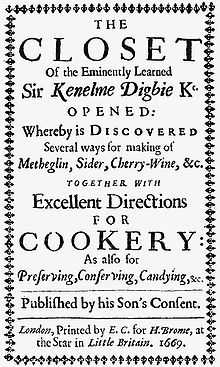The Closet of the Eminently Learned Sir Kenelme Digbie Kt. Opened

The Closet of the Eminently Learned Sir Kenelme Digbie Kt. Opened,[1] first printed in 1669, is a 17th-century English cookbook and a resource of the types of food that were eaten by persons of means in the early 17th century. It is supposedly based upon the writings of Sir Kenelm Digby, a privateer whose interests included cooking, medicine, swordplay, astrology, alchemy, literature, and natural philosophy. Recent editions of the book include one from 1910, with an introduction by Anne Macdonell[2] and a 1997 edition edited by Jane Stevenson and Peter Davidson.[3]
History
The work, according to Anne Macdonell, was not intended by the author for publication, but for his own use. It was published by the efforts of others, notably his steward, Hartman, and his son, John.
Format
The book is a resource for those looking into medieval cuisine and cuisine of the Renaissance, especially for those limited, by linguistic expertise, solely to English manuscripts.
Like most historical cookbooks it does not include complete information on the preparation of the foods within; while methods of cooking and ingredients are included, amounts are usually not. This is standard for cookbooks and herbals of this time and earlier.
Modern scholars who work with medieval and ancient cookbooks must engage in the process of redaction to duplicate the dishes within; for cookbooks redaction means a formulation, based upon trial-and-error, of a dish which uses the ingredients and methods in the book. These recipes, with baking times, amounts, and any additional information, are called "redactions," being more than merely translations.
Digby includes a great deal of information, and bridges the period between the era of the Renaissance and the medieval period; it includes suggested uses of the recipes, as, in ancient and medieval times, foods were considered also curative, and the difference between a cookbook and an herbal or medical text, was slight, even non-existent.
Ingredients
Unlike many antique cookbooks, Digby includes a vast array of ingredients, including flowers, vegetables, meats, herbs, spices, alcohol, fruits and berries, eggs, milk, grains, and honey.
Types of recipe
A great deal of the work is taken up with mead and metheglin recipes, but there are recipes for sallets (which we would call salads), eggs, recipes for potage, recipes for meat pie and meat and vegetable pasty, cooked and prepared meats, syllabub, cakes, dessert pies, jellies and puddings and other sweets and desserts. The book is available online.
Notes
- ↑ The complete title of his book is The closet of the eminently learned Sir Kenelm Digbie Kt. opened: Whereby is discovered several ways for making of metheglin, sider, cherry-wine &c. together with excellent directions for cookery: as also for preserving, conserving, candying, &c.
- ↑ The Closet of Sir Kenelm Digby Knight opened, newly edited, with introduction, notes, and glossary, by Anne Macdonell. London: Philip Lee Warner, 1910.
- ↑ The closet of the eminently learned Sir Kenelme Digbie Kt. : opened (1669), edited from the first edition, with introduction, notes and appendices by Jane Stevenson and Peter Davidson. Totnes: Prospect, 1997.